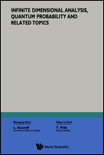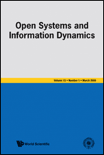
INFINITE DIMENSIONAL ANALYSIS QUANTUM PROBABILITY AND RELATED TOPICS
metrics 2024
Advancing Knowledge in Infinite Dimensions
Introduction
INFINITE DIMENSIONAL ANALYSIS QUANTUM PROBABILITY AND RELATED TOPICS, published by WORLD SCIENTIFIC PUBL CO PTE LTD, is a key academic journal dedicated to the exploration of advanced themes in applied mathematics, mathematical physics, and quantum probability. Since its inception in 1998, the journal has established itself as a critical resource for researchers and professionals in these interdisciplinary fields, currently standing in the third quartile according to the 2023 category rankings. Scholars can access a wealth of rigorous articles that delve into infinite dimensional analysis, providing valuable insights pertinent to statistical and nonlinear physics, and offering a platform for pioneering research. This journal not only bridges theoretical frameworks and practical applications but also nurtures a collaborative environment for emerging and established scholars. Through its commitment to advancing knowledge, INFINITE DIMENSIONAL ANALYSIS QUANTUM PROBABILITY AND RELATED TOPICS serves as an indispensable tool for anyone engaged in the forefront of quantum probability research.
Metrics 2024
 0.34
0.34 0.60
0.60 0.70
0.70 33
33Metrics History
Rank 2024
Scopus
IF (Web Of Science)
JCI (Web Of Science)
Quartile History
Similar Journals

PROBABILITY THEORY AND RELATED FIELDS
Pioneering Insights in Probability Theory and ApplicationsPROBABILITY THEORY AND RELATED FIELDS is a premier journal published by SPRINGER HEIDELBERG, dedicated to advancing the field of probability and its applications. With an ISSN of 0178-8051 and an E-ISSN of 1432-2064, this journal has established itself as a leading platform for innovative research, featuring significant contributions to the theories and methodologies in probability, statistics, and uncertainty analysis. Its impressive ranking in the 2023 category quartiles places it in the Q1 tier within Analysis, Statistics and Probability, highlighting its importance in the academic community. The journal is widely recognized for its rigorous peer-review process, ensuring high-quality publications that cater to researchers, professionals, and students alike. Located in Germany at TIERGARTENSTRASSE 17, D-69121 HEIDELBERG, it continues to shape the future of statistical sciences from 1986 until 2024 and beyond. Researchers in the field are encouraged to contribute their findings, ensuring the journal remains at the forefront of innovative statistical research.

INDIANA UNIVERSITY MATHEMATICS JOURNAL
Exploring Innovative Theories in MathematicsINDIANA UNIVERSITY MATHEMATICS JOURNAL is a prominent scholarly publication dedicated to the field of mathematics, characterized by its commitment to advancing academic discourse and research. Published by Indiana University, this journal provides a platform for the dissemination of original research, including innovative theories and methodologies in various areas of mathematics. With an esteemed impact factor placing it in the Q1 category for miscellaneous mathematics and a Scopus rank of #106 out of 399, this journal is recognized for its rigorous peer-review process and high-quality contributions, appealing exclusively to researchers, professionals, and students seeking to expand their knowledge. Although it currently does not offer open access, its extensive archive ranging from 1970 to the present allows for a rich exploration of past and current mathematical explorations. For those looking to stay at the forefront of mathematical research, INDIANA UNIVERSITY MATHEMATICS JOURNAL remains an essential resource in the academic landscape.

Journal de l Ecole Polytechnique-Mathematiques
Inspiring Scholars: A Hub for Transformative Mathematical Research.Journal de l Ecole Polytechnique-Mathematiques, published by ECOLE POLYTECHNIQUE in France, stands out as a premier platform for disseminating cutting-edge research in the field of mathematics. With an impact factor reflective of its rigorous academic standards, the journal is categorized in the Q1 Quartile for Mathematics as of 2023, placing it among the top tier of scientific publications. Recognized for its strategic focus on various branches of mathematics, it holds a formidable position within Scopus, ranking 94th out of 399 in general mathematics. Since embracing the Open Access model in 2014, the journal has ensured that vital research findings are accessible to a global audience, thereby fostering collaboration and innovation. With convergence expected until 2024, the Journal de l Ecole Polytechnique-Mathematiques continues to be a significant contributor to the academic community, inspiring both seasoned researchers and emerging scholars from around the world.

JOURNAL OF THEORETICAL PROBABILITY
Bridging Theory and Practice in the World of ProbabilityThe Journal of Theoretical Probability is a prominent academic journal dedicated to the dissemination of cutting-edge research in the fields of probability theory and its applications. Published by Springer/Plenum Publishers, this journal has established itself as a vital resource for researchers and professionals interested in theoretical advancements and practical implementations within the realm of mathematics, particularly in the categories of Statistics and Probability. With an impressive converged publication trajectory from 1988 to 2024, the journal holds a commendable Q2 quartile ranking across various disciplines including Mathematics and Statistics and Probability as indicated in the 2023 metrics. Although not Open Access, the journal continues to attract high-quality submissions that contribute significantly to the field, making it an essential platform for advancing theoretical understanding and fostering academic dialogue. Whether you are a seasoned researcher or a graduate student, the Journal of Theoretical Probability offers valuable insights and rigorous scholarship that can enhance your academic pursuits.

Glasnik Matematicki
Unveiling Groundbreaking Theories in MathematicsGlasnik Matematicki is a prestigious academic journal published by the Croatian Mathematical Society, focusing on a broad spectrum of topics within the field of mathematics. Established in Croatia, this journal has gained recognition for its contributions to the mathematical community, providing a platform for researchers and scholars to share their groundbreaking findings and innovative theories. The journal operates without an open access model, encouraging traditional subscription-based readership, which enhances its standing among journals in the field. With a respectable impact factor and categorized in the Q3 quartile for mathematics (miscellaneous) as of 2023, Glasnik Matematicki is vital for those engaged in advanced mathematical research and education. It aims to disseminate significant mathematical advancements and facilitate scholarly exchange, making it an essential resource for students, professionals, and researchers alike. The journal’s convergence period from 2006 to 2024 marks its ongoing commitment to academic excellence and its relevance in contemporary mathematical discourse.

Acta Mathematicae Applicatae Sinica-English Series
Advancing Mathematical Solutions for Real-World ChallengesActa Mathematicae Applicatae Sinica-English Series, published by Springer Heidelberg, is a prominent journal in the field of Applied Mathematics, recognized for its contributions to the advancement of mathematical applications since its inception in 1984. With an ISSN of 0168-9673 and an E-ISSN of 1618-3932, this journal is indexed in Scopus, achieving a respectable ranking of #453 out of 635 in the category of Applied Mathematics, placing it in the 28th percentile. The journal serves as a critical platform for researchers, professionals, and students alike, aiming to disseminate high-quality original research, innovative methodologies, and applications of mathematics to solve real-world problems. Although it currently does not offer open access, its rigorous peer-review process ensures that only the most impactful studies are published. As part of its commitment to enhancing the mathematical sciences, Acta Mathematicae Applicatae Sinica-English Series plays a vital role in bridging theoretical research and practical applications, making significant contributions to the global scientific community.

ANNALES HENRI POINCARE
Shaping the Future of Physics with Peer-Reviewed ExcellenceANNALES HENRI POINCARE is a prestigious journal published by Springer International Publishing AG, dedicated to advancing research in the fields of Mathematical Physics, Nuclear and High Energy Physics, and Statistical and Nonlinear Physics. With an impressive Q1 ranking in its respective categories as of 2023, this journal is recognized as a vital resource for academic researchers, professionals, and students engaged in frontier studies of theoretical and applied physics. The journal's commitment to high-quality peer-reviewed articles promotes significant contributions to the understanding of complex physical phenomena, making it essential reading for anyone seeking to stay abreast of developments in these dynamic fields. Additionally, ANNALES HENRI POINCARE offers open access options to enhance the visibility and accessibility of groundbreaking research, underscoring its role in fostering collaborative scientific inquiry and innovation. Since its inception in 2000, it has continually provided a platform for scholars worldwide to disseminate their findings and engage with the broader scientific community, thus establishing itself as a cornerstone of academic literature.

Carpathian Mathematical Publications
Empowering Minds, Advancing Mathematics.Carpathian Mathematical Publications, published by Vasyl Stefanyk Precarpathian National University, stands as a significant contribution to the field of mathematics, particularly highlighted by its Q2 ranking in Mathematics (miscellaneous) for 2023. With an ISSN of 2075-9827 and E-ISSN of 2313-0210, this Open Access journal, initiated in 2009, enables researchers and practitioners worldwide to freely access cutting-edge mathematical research, thus promoting knowledge sharing and collaboration. Based in Ivano-Frankivsk, Ukraine, the journal focuses on a broad spectrum of mathematical topics while fostering innovative approaches and interdisciplinary connections within the mathematical community. Its current Scopus ranking of rank #122 out of 399 reflects its growing influence and importance, making it an ideal platform for scholars and students aiming to advance their research and stay abreast of the latest developments in general mathematics.

OPEN SYSTEMS & INFORMATION DYNAMICS
Connecting Disciplines: Where Mechanics Meets Information Dynamics.OPEN SYSTEMS & INFORMATION DYNAMICS, published by World Scientific Publishing Co Pte Ltd, is a leading international journal dedicated to advancing research in the interdisciplinary areas of computational mechanics, information systems, and mathematical physics. With its ISSN 1230-1612 and E-ISSN 1793-7191, the journal has established itself as an influential platform for disseminating original research findings, reviews, and methodologies that address complex systems and dynamics. Its current impact factor reflects a solid reputation within the academic community, particularly amongst researchers in the fields of physics, statistics, and computational sciences. The journal's scope encompasses a diverse array of subjects, earning a Q2 classification in Computational Mechanics and Q3 in multiple other categories, including Fluid Flow and Transfer Processes and Information Systems. By providing open access to a wealth of knowledge, OPEN SYSTEMS & INFORMATION DYNAMICS is committed to fostering collaboration and innovation for students, researchers, and industry professionals alike, positioning itself as a cornerstone of scientific exploration and discovery in Singapore and beyond.

EXPOSITIONES MATHEMATICAE
Exploring Innovative Theories in MathematicsEXPOSITIONES MATHEMATICAE, published by Elsevier GmbH, stands as a significant journal in the realm of mathematics, catering primarily to researchers, professionals, and students. With an ISSN of 0723-0869 and an E-ISSN of 1878-0792, this journal has made its mark in the academic community, boasting a Q2 classification in the miscellaneous mathematics category for 2023, illustrating its prominence within its field. The journal addresses a diverse scope of mathematical topics, encouraging the publication of original research and innovative theories while maintaining rigorous academic standards. As it converges from 2004 to 2024, EXPOSITIONES MATHEMATICAE continues to be an essential resource for advancing mathematical knowledge and fostering scholarly communication, despite being a non-open-access publication. Its location in Munich, Germany further anchors it within a rich intellectual tradition, providing accessibility for the mathematical community worldwide.